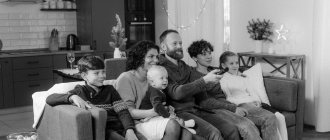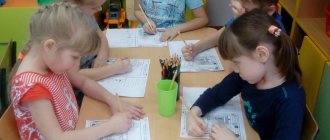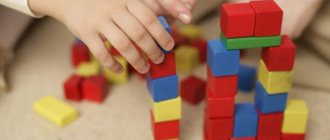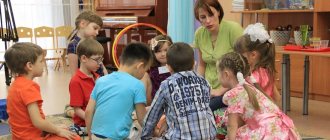Preschooler vocabulary development
The norm at the age of one and a half years is considered to be a vocabulary of fifty words; by the age of five, a child should be able to handle two thousand or more. At first, the child’s speech is enriched by the concepts that he hears from adults. The development of a preschooler’s vocabulary occurs through communication in the family and among peers. But you shouldn’t leave speech formation to the environment - vocabulary develops through reading, educational games, and constant discoveries that the child makes with the help of an adult. You can develop your reserve with the help of games and exercises. Already from the first year of a child’s life, it is necessary to enrich his speech; this will save him from possible delays and failures in school education and in communicating with peers.
What tools can parents use?
Reading and discussion of what you read
The main means of enriching children's vocabulary, as recommended by the methodology, remain reading fiction and active discussion of what they read. Teachers know the methods of such work, but parents should also understand that active verbal communication plays a big role in the accumulation of vocabulary. What do experts advise?
For reading aloud to give positive results, you must:
- pronounce words clearly, maintaining correct articulation;
- correctly place stress in words;
- clarify unfamiliar or difficult to pronounce words;
- constantly use new words in different situations;
- invite the child to express the main idea of the text;
- discuss the characters of the work, their actions, using adjectives.
An effective tool has always been and remains books with colorful pictures, which the child, first with the help of an adult, and then independently, examines and discusses with parents or other children.
Classic vocabulary enrichment tools
- a variety of toys with the help of which the baby learns the names of things and objects and gets acquainted with their qualitative characteristics;
- watching children's films with the obligatory discussion of heroes, events, and supposed actions (“What would you do if you were the hero?”);
- telling favorite fairy tales, memorizing poems, reading tongue twisters outside the preschool curriculum;
- family events that need to be discussed with the child (where to go on a day off, where you like to relax in the summer, what to buy for grandma for her birthday, what to give to a friend, what toys can already be given to your younger brother, and which ones to buy for playing).
There are always plenty of topics for discussion and events to involve preschoolers in the family. The main thing is that parents do not ignore the opinions and reasoning of their child, are ready to answer his questions, and set an example themselves with varied, correct speech. Then the child’s vocabulary will be rich and rich, which will allow him to study successfully at school.
Active and passive vocabulary
There are active and passive vocabulary. The first is the set of words that the child uses every day, which is most convenient and habitual for him to use. It is used in written and oral speech. Passive vocabulary is those words and concepts that the child has encountered in books and heard, but uses extremely rarely. These include, inter alia, historicisms, archaisms, neologisms, and borrowed foreign words.
Replenishment of these reserves occurs throughout a person’s life; each age exhibits its own characteristics of vocabulary formation. Until the age of six, active and passive reserves are still a rather vague concept - speech is enriched with new words, many of the new ones become familiar. With age, the passive reserve becomes significantly larger than the active one. Only the ability to use one’s knowledge makes a child, and later an adult, the owner of real linguistic wealth. What helps a child activate his vocabulary:
- Observation
- Communication with peers and adults
- Borrowing
- Reading, reading analysis
Often a child knows a lot of words, but is embarrassed to use them, or does not find the right moment, and the words lie like a dead weight. To prevent this from happening, you need to translate words from a passive vocabulary into an active one, explaining their meanings, coming up with a situation for their use, that is, giving them an independent life in the baby’s speech through pronunciation. You can select examples from the literature.
What to do if a child knows words, but does not use them in conversation?
Much attention should also be paid to how often the child uses certain words in conversation. The technique reveals such a concept as a “dead word” - not activated, found only in the passive dictionary of a preschooler. It is not used for certain reasons: the preschooler does not understand the meaning of the word or is not involved in the scope of its use. It is important for parents to know what passive vocabulary their child knows in order to translate “dead words” into an active vocabulary. If an adult is faced with such a problem, then he should know:
For a preschooler, it is important to explain each new word: its meaning, use in a certain situation, expressive (emotional) connotation. Then the adult must pronounce the new word with clear articulation so that the pronunciation is fixed in the child’s memory.
- It’s good if an adult remembers works of art in which the “dead word” is used: poetic lines, a fairy tale, a story.
- Experts advise using life situations when these words can be interpreted from the opposite point of view, that is, choosing antonyms.
Replenishing a child’s vocabulary with different types of parts of speech
Between one and three years of age, a child remembers the following:
- what are the names of your loved ones;
- what are the toys called?
- how household items are designated (food, dishes, hygiene items, etc.)
- natural phenomena;
- Seasons;
- easy names of plants and animals
A child’s vocabulary at this age has not yet been replenished with words that allow him to clearly express his assessment or emotions.
By the age of four or five, a child’s speech is already filled with a larger volume of words; he operates in a completely different way with concepts that have already been learned. What does a preschooler remember at this time:
- Labeling feelings (sad, happy, angry, etc.)
- Qualitative characteristics of objects (low, cold, light, etc.)
- How to correctly create a diminutive form of the word (son, daddy)
- Cognate words: (rook-rook; cat-kitten-cat)
By the age of five or six, a preschooler, as a rule, has already mastered about three thousand or more words; he knows the following:
- Time designation - days, weeks, hours, minutes, etc.
- Designation of space - right, left, sideways, etc.
- Simple and complex numbers
- The name of peoples, countries, the designation of social phenomena - labor, state, etc.
The child increases his stock of verbs and nouns most quickly, and adjectives more slowly. Since it is this part of speech that gives imagery to the conversation and saturates it, adults should pay attention to the descriptive and qualitative characteristics of objects and phenomena.
Expanding your vocabulary with games and activities
How does the mechanism for enriching a child's vocabulary work? The child first hears the word, then understands what it means, remembers it, and only then begins to put it into practice. Almost all games and tasks for replenishing a child’s vocabulary are built on this scheme.
"Conductor". The game is built on the trust of an adult in a child. The companion asks the baby to accompany him. He closes his eyes and allows the baby to talk about everything he saw on a walk or at home. At the same time, the child is reminded that he needs to describe in as much detail and accurately as possible everything that he sees around him. An additional condition may be a request not to use the same words.
"Ball Game" Such exercises develop vocabulary and logic, generalize knowledge in the field of lexical groups. For example, the leader throws a ball, and everyone who catches it must name a new animal. Anyone who fails to do this is eliminated from the game. The same game can be played with the names of fruits, plants, vegetables, etc.
A variant of the same task is “who lives where?” The presenter throws the ball, asking: “Who lives in the ocean?”, “Who lives in a tree?”, “Who lives in the forest?”. Children answer in turns, inventing new inhabitants of the above-mentioned places. This exercise helps expand vocabulary and develop knowledge about the environment.
"Big small". In this exercise, the preschooler forms words with a diminutive meaning. The presenter says “mom”, the child answers “mommy”; The leader throws the ball, saying “table”, the child throws it back, saying “table”, and so on. This is not the easiest task, so the kids are given time to think about the answers.
Variant of the ball game “Edible-inedible”. The host names what you can eat, the children name what you can’t, and vice versa.
"Package". Each player receives an oral “package” (the presenter tells him in confidence what is in it). Participants describe their package so that others can guess what is in it
"Analogies". Children learn to derive “vocabulary formulas.” On the paper it is written: “a cat is an animal, a sparrow?” The child’s task is to assign the word to a specific thematic group.
“Finish the sentence.” The adult says the phrase, but does not finish it, and the child comes up with the ending. For example: “The cat jumped on the table, and...”; “Katya woke up, went to the window and saw...” The older the child, the more varied the stories will be. From such sentences, you can compose a whole fairy tale with your child.
Formation of graphomotor skills in children with general speech underdevelopment
"Find the object." The adult thinks of a letter, the child finds objects that begin with it.
“Pick up a word.” The adult names the adjective, and the child looks for a noun for it. For example, the table and bread can be hard. Soft - a blanket and a cat. Then the rules change. The presenter says a noun, the participant selects an adjective. Sugar – sweet, crumbly; snow – wet, cold.
When choosing games and activities, you should take into account the child's temperament. Active preschoolers will enjoy playing ball; calm children will enjoy a descriptive exercise, when they need to analyze phenomena, name objects and talk about what they saw.
These and other games that you can come up with yourself will not only replenish your child’s verbal skills, but will also increase his self-esteem and make him have fun. Most of these tasks take no more than fifteen minutes and can be done on the way to the garden, on a walk, or at home. Experts recommend ending the game before the child himself asks for it. Then he will want to continue it tomorrow and the next day.
Observation with comments
From the very birth of the baby, start talking to him: the baby must get used to the sound of human speech. Lesson options:
- While walking, tell your baby everything you see. Try to make the story picturesque and figurative: use many adjectives, use synonyms. An example of a good description: “This is a tree. It is green, bright, with lush foliage. And how big, tall and majestic it is! This is a truly gigantic tree!” Try to comment on events emotionally: say how you feel from contemplating a rainbow or how you feel when a hot object touches your hand.
- An eight-month-old child can already be taught about the structure of the body. Touch it and say: “This is a pen, your pen; little pink hand." Then show your hand and say: “This is my hand: look how big it is.” Remember to use as many adjectives as possible.
- Organize a joint observation of something: a pet, an insect, a tree swaying in the wind, or something happening on the street. At the same time, comment on what is happening: “Look, a grasshopper is crawling along a leaf. Now he moved his paw. Funny, isn't it? Oh, that’s it, he galloped away.” If possible, let your child touch, smell, or even lick the observed object.
- You can conduct several experiments with your child. Bring his hand to the cat’s fur and say: “This is a cat; It’s soft, warm and smooth.” Then invite the baby to hold a piece of ice and say: “This is cold, hard and wet ice.”
- From the age of 2, you can purposefully introduce new lexical units into your child’s vocabulary. To do this, you must demonstrate the object to the child, say its name several times and make sure that the baby remembers it. Try to do it naturally. On a walk, as if by the way, show him a tree and say: “This is a spruce.” Point to another spruce and say again: “And this is a spruce.” Then, pointing to the tree, ask: “Do you think this is a spruce?” To make sure that your child remembers the word, point to the spruce and ask: “What kind of tree is this?”







